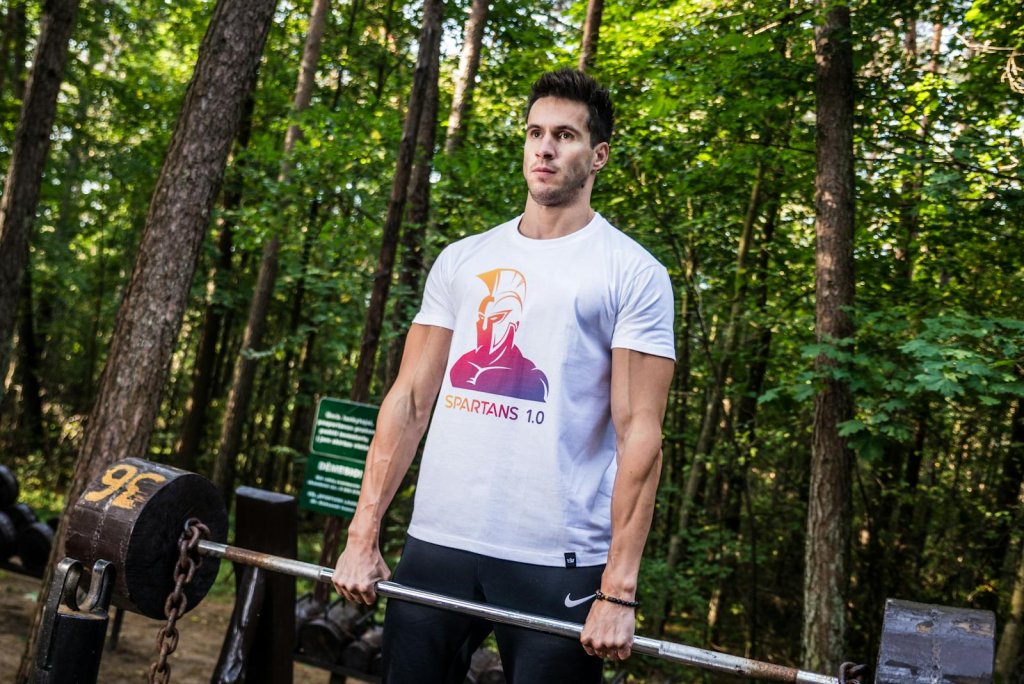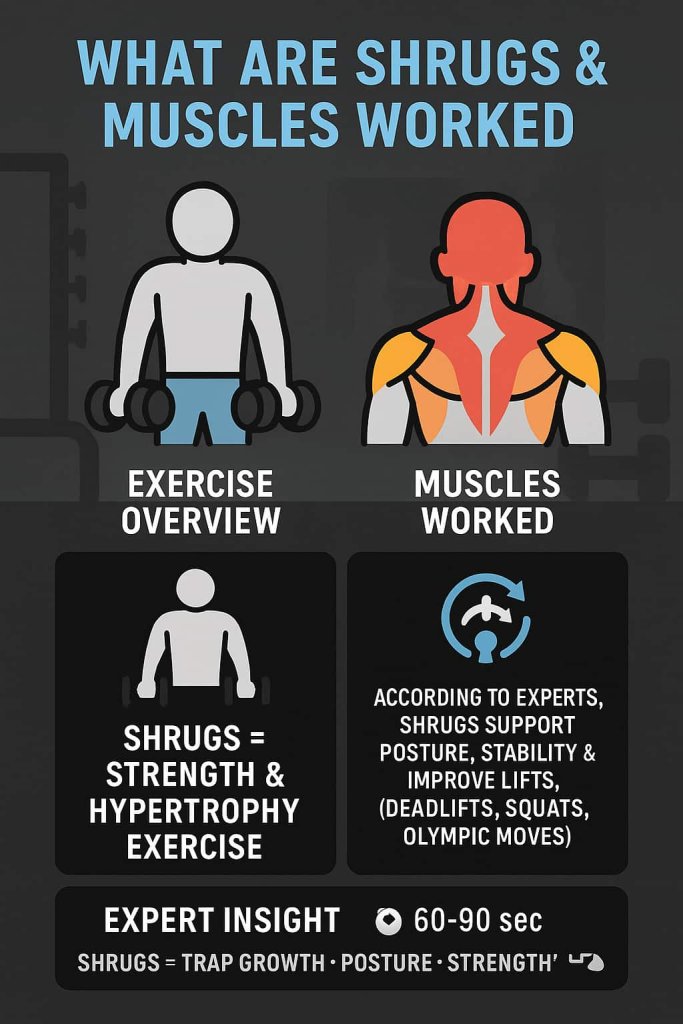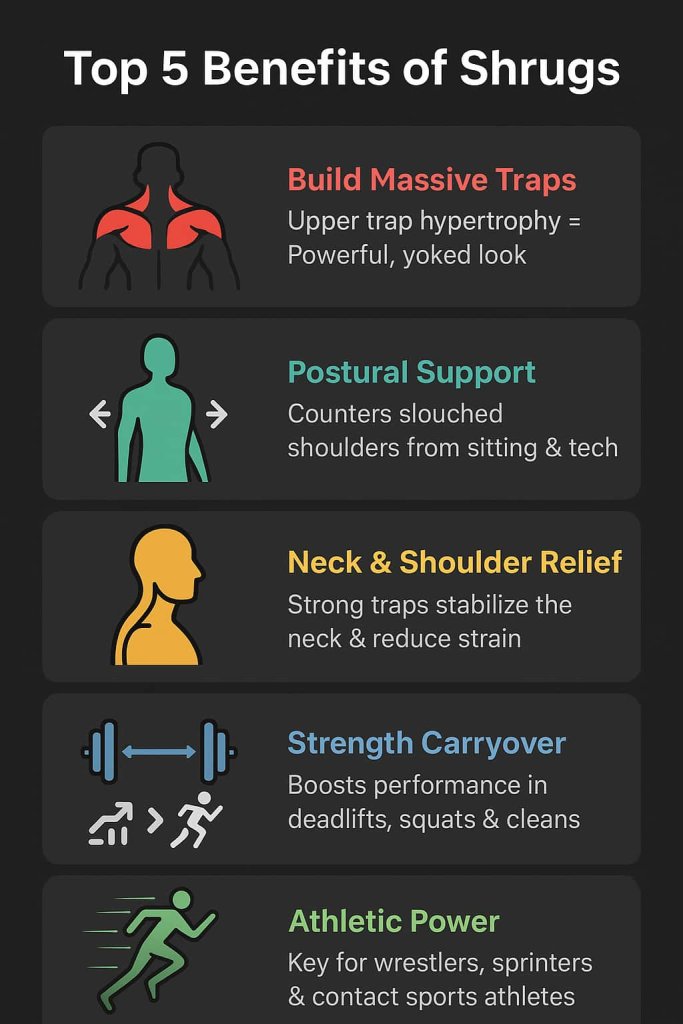Yes, shrugs are one of the most effective exercises to build strong, defined traps while supporting posture, strength, and even neck pain relief. When done correctly, shrugs isolate the trapezius muscle, helping lifters achieve the powerful “yoked” look while reducing the risk of shoulder injuries.

Understanding proper form, variations, and training tips is crucial, because shrugs are often performed incorrectly with rolling shoulders or excessive weight. In this guide, you’ll learn how to perform shrugs safely, their benefits, best variations, common mistakes, and expert tips to maximize gains while preventing injuries.
What Are Shrugs?
Shrugs are a strength and hypertrophy exercise that primarily target the upper trapezius, the muscle running along the neck and upper back. The movement involves elevating the shoulders straight upward, holding briefly at the top, and then lowering under control.

Muscles Worked
- Primary: Upper trapezius
- Secondary: Middle traps, levator scapulae, rhomboids, forearms
👉According to experts, shrugs play a key role in shoulder stability, posture, and carryover to compound lifts like deadlifts, squats, and Olympic movements.
Benefits of Shrugs

Shrugs do more than just add size to your traps. Here’s why they should be in your program:
- Build Massive Traps → Upper trap hypertrophy gives the “powerful” look.
- Postural Support → Counters slouched shoulders caused by sitting and tech use.
- Neck & Shoulder Relief → Strong traps stabilize the neck, reducing strain.
- Strength Carryover → Supports heavy lifts like deadlifts, squats, cleans, and presses.
- Athletic Power → Important for wrestlers, sprinters, and contact sports athletes.
A Steel Supplements article also notes that dumbbell shrugs can help with neck pain by strengthening supporting muscles.
How to Do Shrugs with Perfect Form
Follow these step-by-step instructions to maximize activation and prevent injury:
- Setup
- Stand tall with feet shoulder-width apart.
- Hold a barbell or dumbbells at your sides with overhand grip.
- Execution
- Pull your shoulders straight upward (not forward or rolling).
- Pause for 1–2 seconds at the top to squeeze the traps.
- Lower slowly, allowing a full stretch at the bottom.
- Trainer Tips
- Avoid bending elbows or jerking the weight.
- Use lifting straps if grip gives out before traps.
- Keep reps controlled—no bouncing or momentum.
👉 Trainers warn that rolling your shoulders during shrugs adds unnecessary strain without improving trap activation.
Best Shrug Variations
To keep training balanced and prevent plateaus, rotate these proven shrug variations:
1. Barbell Shrugs
Why it’s great: The go-to shrug for heavy loading and progressive overload. Perfect for building overall trap mass and brute strength.
How to do it:
- Stand tall holding a barbell with an overhand grip, arms fully extended.
- Keep feet hip-width apart and chest tall.
- Shrug shoulders straight up toward ears, hold briefly, then lower slowly under control.
Trainer Tip: Avoid rolling your shoulders—this doesn’t increase activation and can strain joints. Use straps if grip strength limits your weight.
2. Dumbbell Shrugs
Why it’s great: Offers more freedom of movement and the ability to train each side independently. Perfect for fixing muscle imbalances and improving posture.
How to do it:
- Hold a dumbbell in each hand at your sides, palms facing inward.
- Shrug shoulders as high as possible, pause at the top, then return under control.
Trainer Tip: Lean slightly forward for greater trap activation, but don’t round your back. Squeeze at the top for 1–2 seconds to maximize tension.
3. Cable Shrugs
Why it’s great: Unlike free weights, cables keep tension on the traps throughout the entire range of motion. This makes them especially effective for hypertrophy and joint-friendly training.
How to do it:
- Stand inside a cable station with handles or straight bar set at the lowest setting.
- Grip the handles/bar, stand tall, and shrug straight upward.
- Hold briefly, then lower slowly with control.
Trainer Tip: Perform these at the end of a workout for a pump and added volume. Keep the reps slow and controlled—avoid bouncing.
4. Smith Machine Shrugs
Why it’s great: The guided bar path provides stability, allowing lifters to focus purely on trap contraction without worrying about balance. Great for beginners or those rehabbing from injuries.
How to do it:
- Stand under the Smith machine bar, grip it with both hands.
- Unrack the bar, stand tall, and shrug upward.
- Hold for a pause, then lower slowly.
Trainer Tip: Position feet slightly forward to reduce knee strain. Use a controlled tempo (e.g., 2 seconds up, 3 seconds down).
5. Overhead Shrugs
Why it’s great: A less common variation that engages traps in a vertical plane. Not only builds trap strength but also improves posture, shoulder health, and pressing performance.
How to do it:
- Press a barbell, dumbbells, or even a weight plate overhead.
- Lock elbows out, then shrug shoulders upward, pushing weight slightly higher.
- Lower slowly without bending elbows.
Trainer Tip: Start light, as stability overhead is challenging. This variation is excellent for athletes and lifters who struggle with shoulder positioning in overhead lifts.
6. Behind-the-Back Shrugs
Why it’s great: Shifts emphasis to the middle traps and adds a unique angle of contraction. Great for creating fuller, denser traps.
How to do it:
- Hold a barbell behind your thighs with overhand grip.
- Stand tall and shrug shoulders straight upward.
- Lower back down slowly.
Trainer Tip: Use lighter weights until balance and control improve. Perform near a rack or spotter for safety, as grip and positioning are tricky.
Common Mistakes to Avoid
Even seasoned lifters make errors with shrugs. Here’s what to avoid:
- ❌ Rolling shoulders → Increases joint strain, not trap activation.
- ❌ Using excessive weight → Limits range of motion, encourages momentum.
- ❌ Shrugging straight vertical only → Can overwork levator scapulae instead of traps.
- ❌ Bouncing reps → Reduces time under tension and effectiveness.
Programming Shrugs for Gains & Relief
- For Hypertrophy (Muscle Growth): 3–4 sets of 8–12 reps with moderate-heavy weight.
- For Strength & Athletic Carryover: 3–5 sets of 5–8 heavy reps (use straps if needed).
- For Posture & Relief: 2–3 sets of 12–15 lighter reps, focusing on stretch and control.
FAQs About Shrugs
1. Are shrugs enough to build big traps?
Shrugs are excellent but should be combined with deadlifts, rows, and carries for complete trap development.
2. Should I roll my shoulders during shrugs?
No. Trainers strongly advise against rolling, as it strains joints without increasing trap gains.
3. Do shrugs help with neck pain?
Yes, dumbbell and cable shrugs can improve neck stability, reducing discomfort caused by weak traps.
4. How heavy should I go on shrugs?
Use weight heavy enough to challenge your traps, but still allow controlled form and full range of motion.
5. How often should I do shrugs?
2x per week is ideal for hypertrophy and posture benefits without overtraining.
6. Are dumbbells or barbells better for shrugs?
Both work. Barbells allow heavier loads, while dumbbells offer better range of motion.
Conclusion
Shrugs are one of the simplest yet most effective moves to build massive traps, improve posture, and reduce neck/shoulder strain. With correct form, smart programming, and variation, they deliver both strength and aesthetic benefits.
👉 Add shrugs to your upper body or pull day routine, and watch your traps grow while your posture and performance improve.
